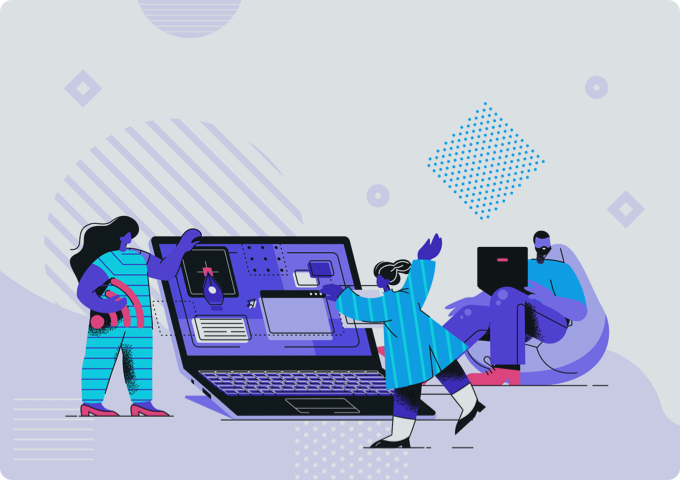

Summary
Talent is the biggest battle for enterprises in the 21st century. In a survey, 74% of CEOs were concerned about the availability of key skillsⅰ. Finding and retaining the right talent is critical for business success. As ways of work and workplaces transform, enterprises and academia must work together to build a resilient talent pool for the new-age techenterprise. We got talking to Kisha Gupta, Head of Global Academic Relations at Infosys, to understand where the talent tide is going.
- Could you give us a view into the talentscape today? What is happening on the academia side, what are people learning, what skills they’re developing, and what skills we see being important in the years to come?
-
The world is moving towards technology centricity. I don’t think this pandemic could have been handled the way it was had it not been for the technological progress we have in the world. In a McKinsey survey 67% of companies stated that technology capabilities were a key factor of success during the crisisⅱ. Obviously there’s an unprecedented demand of talent in that space. However, other than that, one area that has seen a lot of progress, and an upsurge in interest, in the last few years is the liberal arts. An unprecedented number of students have picked up liberal arts subjects over STEM subjects. People highly qualified for STEM are opting to do a Master’s degree in philosophy, learning different languages, moving towards history degrees, economics courses, etc.
As we move into the digital age, we’ll have to up our focus on the human context of technologyⅲ. That’s where liberal arts will play a key role – how do we think, believe, feel, and work. While there is a lot of focus on STEM, I think today more than people who code, we need people who can think about the applications of that code. What are the problems we can solve with technology? How do we apply AI ethically and responsibly? How do we make technology human-centric? That’s where talent is moving. That’s where the balance is – technology and it’s applications in the human context.

- Today, when every business is a technology business, the workforce needs to be more tech-savvy and comfortable working with digital technologies. In a shift towards liberal arts, do you see a skill gap being created?
-
I don’t see these two as disconnected topics but rather a balance we need to create. In fact, these are two extremely interlocked talent pieces. The way technology is being developed and advances in machine learning etc. very soon we’ll not need many people to sit and write millions of lines of code. They will be auto-generated. What we would need is people who can empathize. People who can find more ways in which digital can touch more lives and make life more livable. And that comes from liberal arts or humanities as we call them.ⅱ
Unless and until we understand the landscapes in which technology can foster and develop and do more, we will never be able to amplify the potential of technology to create a high performance enterprise.
- You talked about building a high performance enterprise. How do you define a high performance enterprise and what are some of the key parameters of such an organization especially when it comes to talent?
-
I think a high performance enterprise would be an organization that focuses on profitability, social needs, and sustainability. I don’t think any of this would matter if we stopped to exist.
A high performance enterprise is one that gives back to the community, is highly sustainable, works with empathy, and considers and rewards people. Let me give you and example, I run this program called Infosys InStep which brings together around 250 extremely high caliber students from top tier one schools around the globe. They come from 45 countries and over 100 schools like Cambridge, Harvard, Oxford, MIT, Stanford, etc. The one thing that they’ve all got in common is their curiosity – which is for work and beyond work.
Any high performance enterprise has to recognize that talent resides at different levels. So there have to be avenues to reduce stress. There have to be avenues to explore all different kind of talents that person has and give them a variety of things to do. The more the job rotation possibility, the more we would be able to harness what a person brings to the table rather than what we need to get done.
Most companies when they get interns they tell them on day one – this is your desk, your laptop, your HR, and your manager. And this is what you need to do, get it done in 10-weeks, get a certificate, and go. In this way we are only able to harness the human potential just as much as we think we need.
However, with InStep we take a different approach. We have 300+ projects on our website. We go and ask the intern which one would you like to work on? Which one do you aspire for? So at least a month or so before the project starts, the intern starts learning about it. They get access to all the materials. This allows them a space to grow in an area of their interest. And we rotate them between projects as well – whatever they want to explore.
High performance enterprises will be the ones who are able to find ways to harness talent as they aspire to be harnessed. That is when they will get 2x results.

- Could you also give us a view on how InStep has worked to minimize the impact of the pandemic on new talent?
-
When the pandemic broke out, UNESCO indicated that 1.3 billion students were affected globally. Millions of them had their internship offers revoked. We can’t blame companies given the circumstances, but it’s disheartening and absolutely demotivating for a student to be going through that.
Infosys stepped up at that time and launched an initiative called the summer of ideas – an 8-week immersive experience. We received more than 150,000 applications from over 50 countries from students whose summer internship offers were revoked by their respective organizations. We onboarded 2000 students giving them a platform to learn, engage, get mentored by the best people, and solve something in the real world, rather than feeling that the pandemic has affected their education and their experience. And it continues to make an impact even right now as we speak.
- This new breed of talent that’s coming into a transformed workplace – what will their impact be? And how can their 2x potential be unlocked?
-
The new workforce comes with a different set of priorities – 88% of workers want complete flexibility in hours and location, 69% are more productive when they feel trusted, and 86% prefer to work for companies that prioritize outcomesⅳ .
To unlock the potential of talent we need to create an environment for it to thrive. There are several factors that contribute to this. The first that we’ve already discussed is the agency to choose and with that comes accountability. The second is to allow the freedom of failure and with that comes innovation. I don’t think a lot of organizations really recognize how much your success rate really increases if you allow people to fail or if you give them the option to fail. The third is a focus on problem finding rather than problem solving. People want to do things by choice and because they care. And if enterprises hire the right people, they’re going find the right problems to solve. And that’s what is most important at the end of the day.
Loved what you read?
Get practical thought leadership articles on AI and Automation delivered to your inbox


Loved what you read?
Get practical thought leadership articles on AI and Automation delivered to your inbox
- How do you align the new talent mindset with existing organizational mentality that is set in old ways of working?
-
There is a new reality taking shape and adapting is the only way forward. But adapting to change is a cycle – there is societal and economic change, that pushes regulatory change, that drives behavioral change, and so on.
We can already see that the new trends in talent and economy are pressurizing regulations to change. Once regulations change, internal resistance loses steam. They can stay, or they can leave, but they’ll have to change.
- What does the future of talent look like? Where are we going and what are some of the things that both academia and enterprise should be conscious of?
- There are four key trends I’ve noticed that academia and enterprise need to work together to embrace. These are:
-
A beautiful surge of cross disciplinary degreesⅴ
People are choosing multiple credits in different fields. For instance, earlier people chose to do a Bachelor’s degree in technology and went on to do a Master’s in the same field. Today we have people who do a Bachelor’s in Economics and then move on to Master’s in AI. Academia is also recognizing this interest and offering interdisciplinary programs. This interdisciplinary approach is creating talent that will be more than just tech talent.
-
The recognition of talent coming from community colleges.
These are people who are first generation students, whose parents had never gone to school or college. There is a shortage in the demand-supply paradigm and tapping into this talent can help scale the workforce faster.
-
Decreasing focus on degrees
Companies are looking less for degrees and more skills and for learnability. They are hiring from high-schools! Google offers career certificates to help people without degrees become job ready.ⅵ
-
Rise of the gig-economy
More and more people and companies are embracing the concept of talent on the go. Permanent work from anywhere solutions are going to be a need for tomorrow. And that’s where you can truly create an organization which is diverse and inclusive not just of external settings, but of thoughts.
-
Between academia and corporates, it’s a give and take, demand supply kind of a relationship. As the demand changes from the corporates new degrees and new functions get associated in in academia. Some of our partners like SAP, Salesforce etc. are increasingly looking at talent which is non tech. Not finding the right talent, they backward integrated their courses into universities. Similarly, a lot of times academia pushes forward. The bigger research oriented universities like CalTech are actually working on solutions that will create future jobs, that don’t even exist now.
References:
- https://www.pwc.com/gx/en/ceo-survey/2020/trends/pwc-talent-trends-2020.pdf
- https://www.mckinsey.com/business-functions/strategy-and-corporate-finance/our-insights/how-covid-19-has-pushed-companies-over-the-technology-tipping-point-and-transformed-business-forever
- https://hbr.org/2017/07/liberal-arts-in-the-data-age
- https://tminahancitrix.medium.com/what-employees-really-want-in-2021-d62a9d651b77
- https://qz.com/1589490/to-future-proof-your-career-start-by-embracing-cross-disciplinary-thinking/
- https://analyticsindiamag.com/why-google-believes-you-dont-need-a-college-degree-to-get-a-high-paying-tech-job/





